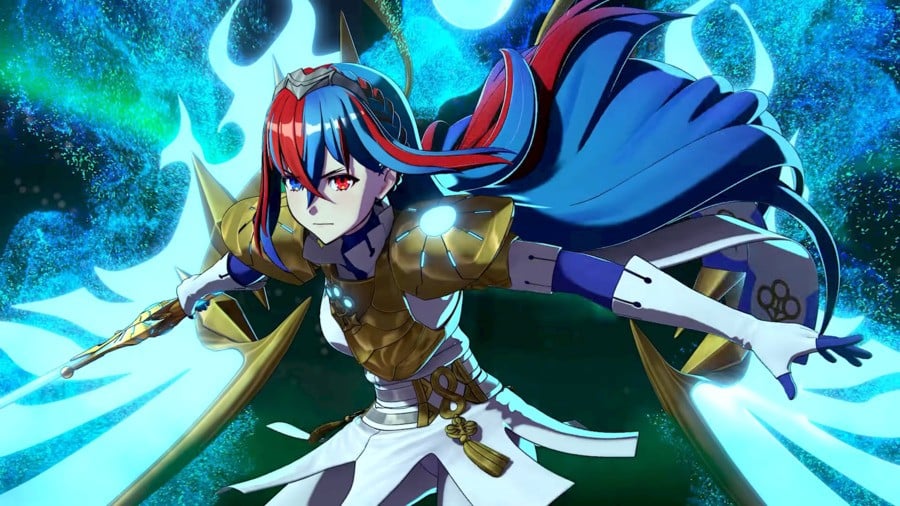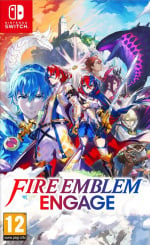Nintendo Life: Engage features a wide roster of characters from Fire Emblems past as Emblems. What factors were considered when picking and choosing which characters to include, and how the DLC characters (like Tiki, Chrom, and the Three Houses leaders) were chosen as well?
Intelligent Systems: For the Emblems who appear in the main story, we selected heroes from throughout the series based on a variety of factors, including whether their abilities are well-suited for Emblem gameplay, as well as their role in the game’s story.
Easy-to-understand examples include Celica and Sigurd. Celica was chosen for her ability to make flashy movements by warping. Sigurd was chosen because his effects are easy to understand in the early game, including movement enhancements that are simple to imagine uses for, and because in story terms he was a suitable replacement for Lumera as someone to provide guidance to Alear and their party.
For the DLC Emblems, we selected characters from as wide a range of generations as possible, while also prioritizing characters with powers or abilities that Emblems from the main game don’t have, such as Manaketes or Flying Units.
Mika Pikazo’s art style has given the game an amazingly colorful and vivid look that really suits the more action-oriented bent of the experience – even if some fans are still undecided about Alear’s wacky hairstyle – can you talk to us a little about the process of selecting an artist? Was it a conscious decision to move away from Three Houses’ more grounded style, and is having each entry in the series look unique, something that you aim for?
To convey to our audience that the world and mechanics differ significantly from the last game, we thought it was necessary to significantly change the art style.
We wanted Fire Emblem Engage to be played not only by existing fans but also by players who are new to the Fire Emblem series, so we reached out to an up-and-coming artist who also has momentum and popularity with younger generations.
Fire Emblem: Three Houses really deepened the social and relationship aspects of the core Fire Emblem experience, something fans really seemed to dig about the game. How nerve-wracking was it to follow up with a title that so obviously redirected the emphasis to action?
We try to develop each game in the Fire Emblem series with a story that works synergistically with the gameplay, while also challenging ourselves and establishing new themes.
the Fell Xenologue came from a desire to give the DLC a drastically different atmosphere from the main game
For Fire Emblem Engage, both story and gameplay development were centred around the Emblem mechanic. As a result, instead of depicting the motivations and personal relationships of each character like in Fire Emblem: Three Houses, this game focuses on the protagonist. We wanted Alear to grow along with their allies as the story progresses, in line with classic Fire Emblem themes. In gameplay terms, the addition of these Emblems allowed us to include more strategic elements than usual.
We are deeply grateful for the positive response the combat has received, and we believe that its success is in large part thanks to the chemistry between the development team’s many years of experience creating strategy games and the Engage system, which enabled us to achieve deep and accessible gameplay.
The main storyline of Fire Emblem Engage doesn’t feature player choice like some of the more recent entries in the series. However, the Fell Xenologue acts like an alternate path in many ways and is full of shocking twists and turns. What made the team want to explore the idea of this mirror Elyos and did it feel like you were almost giving players an alternate campaign route, anyways?
The structure of the Fell Xenologue came from a desire to give the DLC a drastically different atmosphere from the main game.
Most of your allies in the main game have a friendly relationship with the protagonist, the Divine Dragon, but what would happen in a world where that wasn’t the case? That question served as the starting point.
As a dark story where you fight against the friends you became attached to in the main game, we thought it would be good to use that scenario as DLC, allowing the player to choose whether they want to experience that content.
You introduced two brand new class types with the Fell Xenologue, the Enchanter and the Mage Cannoneer. Were there a lot of adjustments that had to be made to make them balanced and not overpowered and were there any other new class types that were considered?
Since this game has the Engage and Style systems, we initially imagined that this DLC would only have additional Emblems. However, we thought many users would expect additional classes, so we considered whether we could include classes with unique abilities that greatly change the game, and we ended up doing so.
Since the Mage Cannoneer attacks using consumable items (shells), the class is quite unusual for this game, which doesn’t use weapon durability. The balancing team also mentioned that it was difficult to find the right range for the class’ long-distance attack. With the ability to use the Convoy and items, the Enchanter features never before seen elements like the ability to use the Convoy despite not being the protagonist, and consuming items.
Both classes have unique abilities with a variety of uses, so we hope you try them out.
There comes a point in the Fell Xenologue where the new character Nel, states that “Nearly all Fell Dragon children lose their twin siblings as they mature.” What reason drives most Fell Dragon children to fight like this? Is there a competition they’re forced to participate in, is it just a feeling they just have in their gut, or is this ideology forced upon them by Lord Sombron?
The Fell Dragon children have a high chance of dying to begin with, whether that be by dying in battle or by being disposed of by Sombron as failures.
Also, the Fell Dragon children each believe fundamentally that they will be their father’s only successor (Evil Veyle says this in the main game as well).
For this reason, it is not uncommon for the children to destroy each other, as each believes that ultimately they need to be the last one left alive. It is quite rare for them to care about their siblings like Alear, Veyle, Nel and Nil do.
The Fell Xenologue gives a certain group of nasty characters a brand new attitude and a new identity, The Four Winds. Why was it important to give these characters a relatable backstory and why were they immune to becoming Corrupted?
Alear is kindhearted, and they will not abandon someone who is capable of changing their ways
We gave them relatable backstories because three of the Four Winds knights become playable in the Fell Xenologue, and we needed to give them characteristics players could get attached to that would make them appealing to use as allies. For the Four Hounds, who were evil, we flipped critical parts of their personalities while retaining most of their original qualities, making it seem like they might have been heroes if something had been different.
As for why they were able to avoid becoming Corrupted, Nil (Rafal) chose not to affect those close to him in order to hide his true identity while working to achieve his goals. More specifically, it’s to prevent Nel from finding him out. If, for example, the Four Winds had crossed over to another country when the war ended, they might have become Corrupted.
Speaking of Corruption, how did the inhabitants of this mirror version of Elyos become Corrupted in the first place?
all of the characters in the game reflect the theme of living as the person they want to be
The royal families returned to their countries after the war ended, but then the war dead of each country became Corrupted. The royal families were attacked and killed by the Corrupted, and in Rafal’s raids. In Chapter 2 of the Fell Xenologue, Nel tells the Firene Royal Family that ever since the Divine Dragon disappeared, the royal families stopped coming to Lythos. In reality, however, they had already become Corrupted.
Rafal resurrected their corpses as Corrupted and altered their memories, allowing them to spend their days prior to the Fell Dragon Xenologue as they had before death. Only Ivy asks Rafal to turn her into one of the Corrupted.
At the end of the Fell Xenologue expansion, Alear invites Nel and Nil to come live in their world if they ever want. Even after all they’ve been through, why do you think it was that Alear would make such a kind gesture?
Because at the start of the Fell Xenologue, Alear’s other self asked them to “save those who are important’ to them. Additionally, Alear is kindhearted, and they will not abandon someone who is capable of changing their ways, no matter what that person has done in the past.
Finally, we wanted to ask about Rosado, the confidently cute yet simultaneously deadly wyvern rider. In one of his support conversations, he talks about the beauty of growing up in a village where people aren’t bound by their genders and can dress and look however they like. What sort of impact are you hoping this character would have on players and can you talk a bit about their creation?
The theme we chose for Fire Emblem Engage is that whoever you were born as, and wherever you were born, if you live your life as the person you want to be, your dream will come true. Alear and Rosado, and to some extent, all of the characters in the game reflect the theme of living as the person they want to be. So while many of the characters might contradict the first impression they give, we hope you can discover who they are through support conversations and so on.
Please note that some external links on this page are affiliate links, which means if you click them and make a purchase we may receive a small percentage of the sale. Please read our FTC Disclosure for more information.
This interview has been lightly edited for clarity.
Thank you to the Intelligent Systems team for taking the time to talk to us. Fire Emblem Engage and the Fell Xenologue DLC are available on Switch right now.


